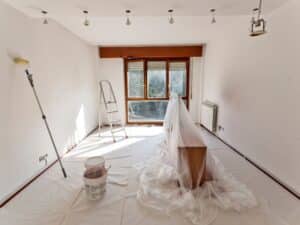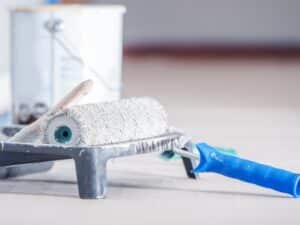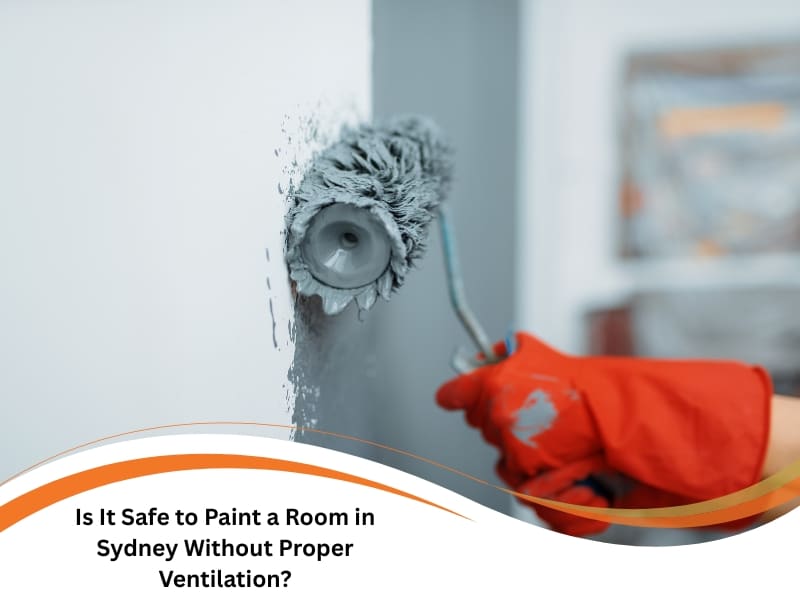Painting a room can instantly transform its look, adding vibrancy and style to your home or office. However, it’s essential to consider one often-overlooked aspect of painting: ventilation. In Sydney’s warm and mild climate, the risks associated with poor ventilation during painting are inconvenient and potentially harmful. This article will explore why proper ventilation is essential and how to paint your room safely and effectively.
What happens if you paint a room without proper ventilation?
If you don’t ensure proper ventilation when painting a room, you could face various health risks. Paint fumes contain volatile organic compounds (VOCs) that can lead to headaches, dizziness, and respiratory issues. The accumulation of these fumes can create an uncomfortable and unsafe environment.
Here’s what can happen:
- Health risks: Prolonged exposure to paint fumes can lead to nausea, dizziness, and respiratory issues.
- Slow drying time: Without adequate airflow, the paint may take longer to dry, leading to issues with smudging or uneven finishes.
- Strong odour: The smell of paint can become overwhelming without proper ventilation, causing discomfort during and after painting.
- Increased risk of allergies: Poor ventilation can trigger allergic reactions in sensitive individuals.
In short, failing to ventilate properly increases the potential for harmful exposure and negatively impacts the quality of your work.
Why is proper ventilation crucial during the painting process?
When painting a room, it’s important to understand the importance of ventilation for healthy indoor air quality. Proper airflow helps disperse harmful fumes, making the space safer to occupy. Simple methods like opening windows, using fans, or other ventilation techniques can significantly reduce the buildup of toxic chemicals in the air.
Benefit | How It Helps | Result |
Air circulation | Removes harmful fumes | Safer workspace |
Faster drying | Enhances airflow | Reduces paint damage |
Toxin control | Lowers chemical buildup | Protects health |
Odour reduction | Clears strong smells | Comfortable environment |
Quality finish | Limits moisture/fumes | Fewer surface flaws |
By ensuring good ventilation during painting, you enhance both safety and the quality of results. It’s a simple yet powerful step in achieving a professional finish.
What precautions should you take before you paint a room?
Before starting any painting project, especially indoors, it’s vital to take the right precautions to ensure the room is safe for both you and the paint. Following a few simple steps will help make your painting experience smoother and safer.
- Check for existing fumes: If you’ve recently cleaned or renovated the room, ensure no lingering fumes from other chemicals are present before painting.
- Choose the right paint: Opt for low-VOC or no-VOC paints to minimise harmful chemical exposure.
- Prepare the room correctly: Move furniture out of the way, cover the floors with drop cloths, and open windows and doors to allow airflow.

- Install temporary fans or air circulators: These devices help direct fresh air into the room while pushing the paint fumes out.
By following the essential steps for preparing a room for interior painting, you can create a safer and more comfortable environment throughout the painting process.
When should you ensure proper ventilation while painting?
Proper ventilation should be a priority both during and after the painting process. Timing is everything—ventilation matters before, during, and after the job. Many people mistakenly believe opening a window while painting is enough, but ongoing airflow is crucial at every stage.
Best times to ventilate your space:
- Before you start painting: Let stale indoor air out and bring fresh air in.
- During painting: Keep air moving constantly to reduce fumes and odours.
- Right after painting: Keep windows and fans running for at least 24–48 hours.
- During curing time: Some paints take up to 7 days to fully cure—maintain ventilation.
- If using spray or oil-based paint: These require even more intense ventilation.
Continuous airflow helps avoid fume build-up and ensures a quality, professional-grade finish.
Who is most at risk from paint fume exposure?
While anyone can be affected by the fumes from fresh paint, some people are at a higher risk. Certain groups should take extra care when painting or working in freshly painted rooms.
Group | Risk Factor | Reason for Sensitivity |
Children | Developing lungs | Susceptible to toxins |
Pregnant women | Fetal health risk | Can affect development |
Elderly people | Weakened immunity | Prone to respiratory issues |
Pre-existing issues | Chronic conditions | Triggered by fumes |
Pets | Higher sensitivity | Affected faster than humans |
If you belong to any of these groups or have concerns, it is important to avoid painting in enclosed spaces without proper ventilation.
Which paints are safer for indoor use?
Not all paints are created equal. Some are designed to be safer for indoor use, minimising health risks associated with VOCs and other chemicals.
- Low-VOC paints: These paints contain fewer volatile organic compounds, reducing the harmful fumes typically released into the air.
No-VOC paints: These paints have minimal to no VOCs, making them an excellent choice for indoor spaces, especially where ventilation is limited. - Eco-friendly paints: Many eco-friendly paints are low in VOCs and made from natural ingredients, making them a safe and sustainable choice.
- Water-based paints: Water-based paints have less odour and are easier to clean up, making them a good option for indoor environments.

When painting indoors, choosing these safer paint options can help you reduce exposure to harmful chemicals and create a safer, more comfortable space.
How can you safely paint a room indoors?
To ensure your painting project is safe and successful, follow these simple tips for creating a well-ventilated and healthy indoor environment.
- Ventilate throughout the process: As mentioned earlier, open windows, use fans, or install an exhaust system if necessary.
- Wear protective gear: Use a mask or respirator to avoid inhaling fumes, particularly if you’re working with paints containing higher levels of VOCs.
- Keep the room well-lit. This will help you identify areas where the paint hasn’t dried properly and give you a clearer view while working.
- Take breaks: Step outside occasionally to get fresh air and avoid prolonged exposure to paint fumes.
Painting indoors doesn’t have to be risky. With the right preparation, proper safety gear, and a bit of common sense, the process can be safe and effective. It’s also a perfect chance to explore high-quality painting solutions for your spaces and give your home a new look.
Conclusion
In conclusion, it’s crucial to ensure proper ventilation when painting a room in Sydney. Taking the proper precautions allows you to enjoy a fresh, vibrant space without compromising your health. Whether you’re painting your home or business, prioritising safety will lead to a better outcome and a safer environment.
Considering a refresh for your Sydney property? Connect with Sydney Paintmasters for a consultation.

